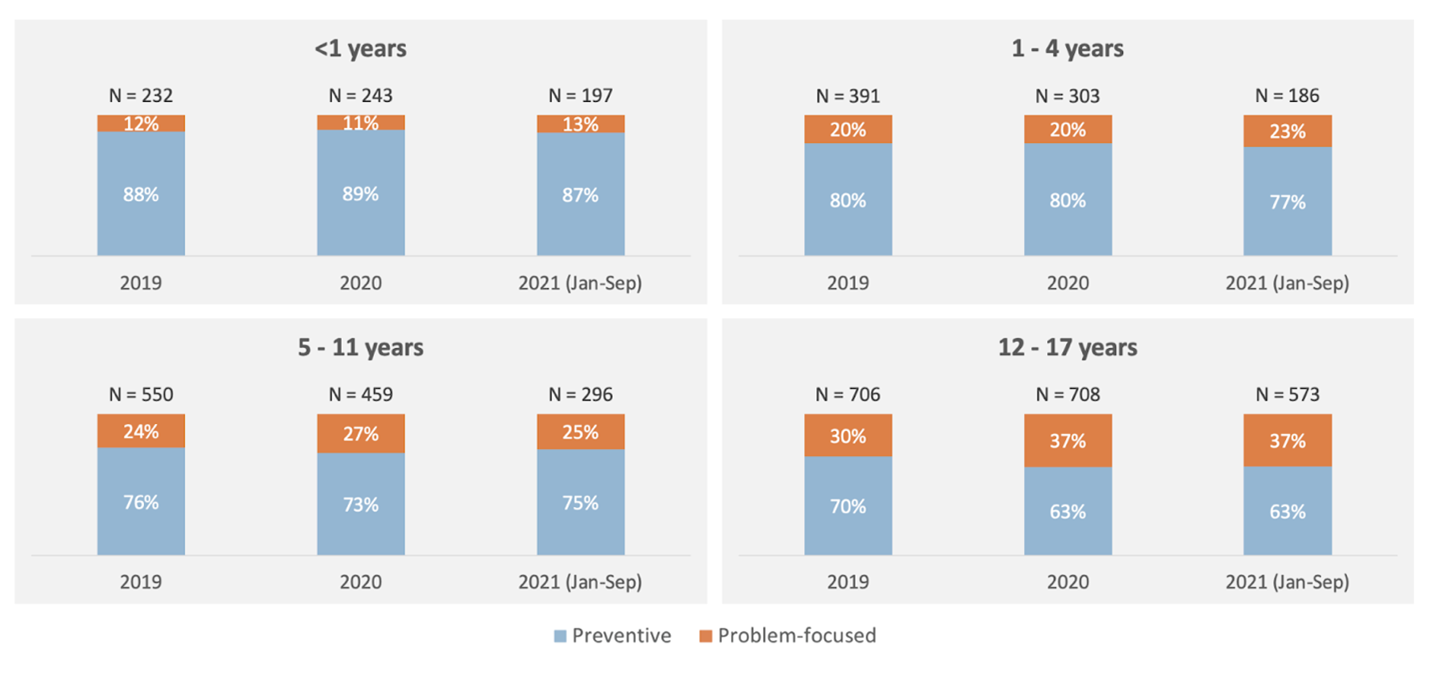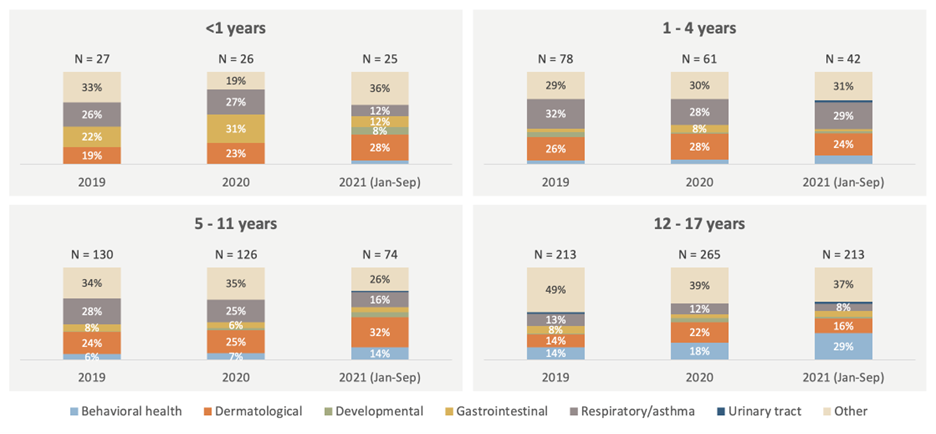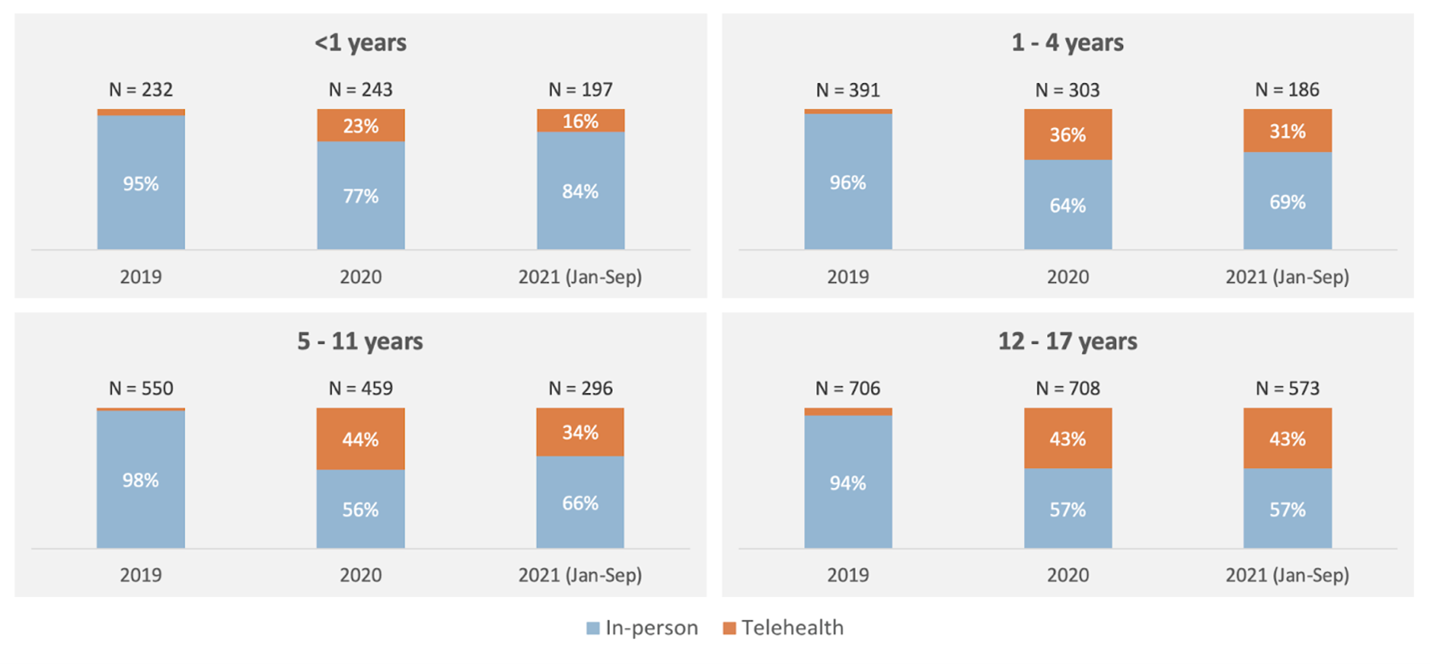Background and Objectives: The COVID-19 pandemic impacted the volume and nature of pediatric primary care visits nationwide. This study aimed to identify trends in pediatric visits at our institution during the pandemic to reveal opportunities to improve care of children and adolescents.
Methods: We performed a retrospective chart review of all pediatric visits conducted at a single family medicine clinic within a large academic medical center in Northern California from January 1, 2019, through September 30, 2021. Data collected for each visit included age, sex, type of visit (preventive or problem-focused), reason for visit (if problem-focused), and mode of visit (in-person or telehealth). We analyzed data using descriptive statistics and χ2 tests.
Results: A total of 4,844 pediatric visits occurred during the study period. Visit volume dropped 9% from 2019 to 2020 and recovered to prepandemic levels in 2021. During the study period from 2019 to 2021, the percentage of problem-focused visits increased from 30% to 37% (P=.008) among adolescents, driven largely by an increase in the percentage of behavioral health visits from 14% to 29% (P<.001). We found no significant changes in the age or sex of patients seen. Telemedicine visit volume decreased from 2020 to 2021 in all age categories except for adolescents, which remained stable at 43% of all visits.
Conclusions: A sharp increase in behavioral health concerns among adolescents stands out as the most notable impact of COVID-19 on pediatric care at our institution. Our findings raise questions about how behavioral health care can be optimized for adolescents in the postpandemic era.
The COVID-19 pandemic resulted in widespread changes to how primary care is delivered across the United States and resulted in a sharp decline in pediatric visits. 1, 2 In response to the pandemic, primary care adopted a widespread shift from in-person to telemedicine visits. In pediatric care, telemedicine visits increased from <1% of visits prepandemic to as much as 80% of visits during the pandemic to manage acute illnesses, chronic conditions, and behavioral health concerns. 3, 4
While substantial literature is available on the effects of the pandemic and rapid adoption of telemedicine for primary care among adults, information about the effects of COVID-19 on the use of telemedicine among pediatric patients is limited. 5-7 More evidence is needed to determine whether telemedicine works well across different age groups and for different types of pediatric concerns.
Because telemedicine likely will continue to be used as a method of care delivery, better understanding both the opportunities and barriers to using telemedicine in pediatric primary care is essential. In this study, we aimed to assess how the volume and nature of pediatric visits at our institution changed during the pandemic to identify trends and reveal opportunities to improve care of children and adolescents.
Setting
We conducted retrospective chart reviews using the electronic health records for all pediatric visits that took place between January 1, 2019, and September 30, 2021, at Stanford Family Medicine (SFM). SFM is a single family medicine clinic, within a large academic medical center in Northern California, that cares for 11,700 patients, of which 840 (7%) are pediatric patients.
Data Collection
For each visit, investigators noted the patient’s age, sex, visit mode (in-person or telemedicine), and visit type (preventive or problem-focused). Investigators determined visit type by reviewing the visit diagnoses, reason for visit, and/or history of present illness (HPI) in the visit note. If the visit was primarily problem-focused, investigators identified a primary concern by reviewing the visit note for a chief complaint or identifying the first problem listed in the HPI and assigned the primary concern to a category: behavioral health, dermatological, developmental, gastrointestinal, respiratory/asthma, urinary tract, or other. These categories were based on and adapted from prior research on pediatric primary care visits. 8, 9
Data Analysis
We descriptively summarized the number of outpatient pediatric visits—overall, by visit mode, and by visit type—for four age groups (<1, 1–4, 5–11, 12–17 years) and across each year in the study period (2019, 2020, and January-September 2021). Data for October-December 2021 were not available at the time this study was conducted. We compared the percentages of visits by mode and type between years using χ2 tests. The Stanford University Institutional Review Board determined this study to be exempt from review.
A total of 4,844 pediatric visits occurred during the 33-month study period. Compared to baseline levels in 2019, visit volume dropped 9% in 2020, mostly during April and May 2020, corresponding to the onset of the COVID-19 pandemic. Visit volume began to increase in June and July 2020 and appeared to stabilize back to prepandemic levels in 2021 (Figure 1 ). The spike in visits seen in the fall represents a typical seasonal event associated with the start of the school year.
Preventive visits accounted for 76% (1,430/1,879) of all visits in 2019, 72% (1,235/1,713) in 2020, and 72% (898/1,252) in 2021. We found no significant changes to the percentage of preventive versus problem-focused visits in the <1, 1 to 4, and 5 to 11 age groups throughout the study period, but the percentage of problem-focused visits increased from 30% to 37% (P=.008) from 2019 to 2021 among adolescents aged 12 to 17 years (Figure 2). This increase corresponded to a significant increase in the percentage of behavioral health visits, from 14% to 29% (P<.001), among adolescents from 2019 to 2021 (Figure 3). Another notable increase was in the percentage of behavioral health visits, from 6% to 14% (P=.075), in the 5 to 11 age group from 2019 to 2021.
Telemedicine visits accounted for 4% (78/1,879) of all visits in 2019, 39% (674/1,713) in 2020, and 35% (439/1,252) in 2021. All age groups showed a significant increase in the percentage of telemedicine visits from 2019 to 2020. Telemedicine visit volume subsequently decreased from 2020 to 2021 in all age groups except among adolescents aged 12 to 17 years, which remained stable at 43% of all visits (Figure 4 ).
The volume and nature of pediatric visits at our institution changed significantly following the onset of the COVID-19 pandemic. A sharp increase in behavioral health concerns among adolescents stands out as the most notable trend. This shift is in alignment with existing literature; a study of 45 pediatric primary care practices found that behavioral health concerns were among the most common presenting complaints during COVID-19. 10
Our study was limited by its single-site nature; however, our findings are consistent with recent news and growing evidence. In October 2021, the American Academy of Pediatrics declared a national emergency in child and adolescent mental health, 11 and in December 2021, the US Surgeon General issued an advisory to highlight the urgent need to address the nation’s youth mental health crisis. 12 In March 2022, the Centers for Disease Control and Prevention released data stating that one in three high school students reported experiencing poor mental health during the pandemic, and nearly half reported feeling persistently sad or hopeless. 13 A recent systematic review showed that adolescents demonstrated a higher level of anxiety, depression, and substance abuse in 2021 than in 2019. 14
The sustained increase in the use of telemedicine amidst a rise in behavioral health-focused visits among children and adolescents in our study suggests an opportunity to leverage the unique nature and ease of virtual care delivery to address the increasing volume of mental health concerns in this population. Telemedicine is particularly well-suited for addressing behavioral health concerns, which often require frequent follow-up and can be managed without in-person physical examinations. 15, 16 Telemedicine has been successful in delivering cognitive behavioral therapy and pharmacological interventions to pediatric patients 17 and touted for its potential to improve access to care by facilitating appointments in underserved regions and to lower costs by reducing unnecessary resource use. 16
However, uptake and effective use of telemedicine relies on factors including digital literacy, access to devices, and access to broadband Internet, which tend to be lower among those with lower incomes and less education. 18, 9, 19, 20 Because telemedicine is increasingly used to deliver care, intentional efforts must be taken to ensure that existing health inequities are not exacerbated. Moreover, when addressing adolescents’ behavioral health concerns, privacy is of paramount importance. In an in-person setting, providers can establish a quiet, safe environment for patients; in a virtual setting, this may not be feasible, particularly if the patient is using a parent’s device or if space is limited in the household.
In conclusion, from 2019 to 2021, behavioral health-focused and telemedicine visits increased among pediatric patients at SFM, particularly youth aged 5 to 17 years. An opportunity exists to leverage virtual care delivery to address mental health concerns among youth in the United States. Further research and best practice guidelines addressing privacy and equity challenges are needed to optimize pediatric behavioral health care using telemedicine.
This project was presented at the Society of Teachers of Family Medicine’s Annual Spring Conference in Indianapolis, Indiana (April 30–May 4, 2022) and the North American Primary Care Research Group’s Annual Meeting in Phoenix, Arizona (November 18–22, 2022).
References
-
Brown CL, Montez K, Amati JB, et al. Impact of COVID-19 on pediatric primary care visits at four academic institutions in the Carolinas.
Int J Environ Res Public Health. 2021;18(11):5734.
doi:10.3390/ijerph18115734
-
Macy ML, Huetteman P, Kan K. Changes in primary care visits in the 24 weeks after COVID-19 stay-at-home orders relative to the comparable time period in 2019 in metropolitan Chicago and northern Illinois.
J Prim Care Community Health. 2020;11.
doi:10.1177/2150132720969557
-
Howie F, Kreofsky BL, Ravi A, Lokken T, Hoff MD, Fang JL. Rapid rise of pediatric telehealth during COVID-19 in a large multispecialty health system.
Telemed J E Health. 2022;28(1):3-10.
doi:10.1089/tmj.2020.0562
-
Curfman A, McSwain SD, Chuo J, et al. Pediatric telehealth in the COVID-19 pandemic era and beyond.
Pediatrics. 2021;148(3):e2020047795.
doi:10.1542/peds.2020-047795
-
Koonin LM, Hoots B, Tsang CA, et al. Trends in the use of telehealth during the emergence of the COVID-19 pandemic—United States, January–March 2020.
Morb Mortal Wkly Rep. 2020;69(43):1,595-1,599.
doi:10.15585/mmwr.mm6943a3
-
Mann DM, Chen J, Chunara R, Testa PA, Nov O. COVID-19 transforms health care through telemedicine: evidence from the field.
J Am Med Inform Assoc. 2020;27(7):1,132-1,135.
doi:10.1093/jamia/ocaa072
-
Punia V, Nasr G, Zagorski V, et al. Evidence of a rapid shift in outpatient practice during the COVID-19 pandemic using telemedicine.
Telemed J E Health. 2020;26(10):1,301-1,303.
doi:10.1089/tmj.2020.0150
-
Schweiberger K, Patel SY, Mehrotra A, Ray KN. Trends in pediatric primary care visits during the coronavirus disease of 2019 pandemic.
Acad Pediatr. 2021;21(8):1,426-1,433.
doi:10.1016/j.acap.2021.04.031
-
Schweiberger K, Hoberman A, Iagnemma J, et al. Practice-level variation in telemedicine use in a pediatric primary care network during the COVID-19 pandemic: retrospective analysis and survey study.
J Med Internet Res. 2020;22(12):e24345.
doi:10.2196/24345
-
-
-
-
Jones EAK, Mitra AK, Bhuiyan AR. Impact of COVID-19 on mental health in adolescents: a systematic review.
Int J Environ Res Public Health. 2021;18(5):2470.
doi:10.3390/ijerph18052470
-
Brophy PD. Overview on the challenges and benefits of using telehealth tools in a pediatric population.
Adv Chronic Kidney Dis. 2017;24(1):17-21.
doi:10.1053/j.ackd.2016.12.003
-
Utidjian L, Abramson E. Pediatric telehealth: opportunities and challenges.
Pediatr Clin North Am. 2016;63(2):367-378.
doi:10.1016/j.pcl.2015.11.006
-
Ros-DeMarize R, Chung P, Stewart R. Pediatric behavioral telehealth in the age of COVID-19: brief evidence review and practice considerations.
Curr Probl Pediatr Adolesc Health Care. 2021;51(1):100949.
doi:10.1016/j.cppeds.2021.100949
-
Katzow MW, Steinway C, Jan S. Telemedicine and health disparities during COVID-19.
Pediatrics. 2020;146(2):e20201586.
doi:10.1542/peds.2020-1586
-
Kruse C, Heinemann K. Facilitators and barriers to the adoption of telemedicine during the first year of COVID-19: systematic review.
J Med Internet Res. 2022;24(1):e31752.
doi:10.2196/31752
-
Barney A, Buckelew S, Mesheriakova V, Raymond-Flesch M. The COVID-19 pandemic and rapid implementation of adolescent and young adult telemedicine: challenges and opportunities for innovation.
J Adolesc Health. 2020;67(2):164-171.
doi:10.1016/j.jadohealth.2020.05.006
-
Katzow MW, Steinway C, Jan S. Telemedicine and health disparities during COVID-19.
Pediatrics. 2020;146(2):e20201586.
doi:10.1542/peds.2020-1586







There are no comments for this article.